Written by Elma Steven | Updated on June, 2024

How Do I Write the Physical Therapy Business Plan?
Physical Therapy Business Plan is an outline of your overall physical therapy business. The business plan should includes a 5 year financial projection, marketing plan, industry analysis, organizational overview, operational overview and finally an executive summary. Remember to write your executive summary at the end as it is considered as a snapshot of the overall business plan. You need to be careful while writing the plan as you need to consider various factors that can impact the business’s success.
Table of Contents
Executive Summary
Dr. Emily Clark’s Revive Physical Therapy Solutions is a shining example of cutting-edge practice in the heart of Boston’s medical sector. Physical therapy specialized rehabilitation programs, injury prevention education and wellness coaching are the foundations of our practice. Dr. Clark has been practicing physical therapy for over 15 years during which time he has amassed an extensive knowledge base and developed a caring attitude toward his patients.
Mission: Our mission is to be the go-to authority on the benefits of exercise and active lifestyles and to help push the field forward.
Vision: We envision a world where exceptional physical therapy care empowers individuals to reclaim their movement, live healthier and happier lives.
Industry Overview:
The future of the physical therapy (PT) business in the United States is bright and expanding. We anticipate the market will increase from its projected $36.4 billion in 2023 value at a CAGR (compound annual growth rate) of 3.4% during the following five years. Several causes such as an aging population an increase in the frequency of chronic diseases and a greater emphasis on preventative treatment will drive this expansion.
Check out this guide on how to write an executive summary? If you don’t have the time to write on then you can use this custom Executive Summary Writer to save Hrs. of your precious time.
Financial Highlights
Revenue & Earnings

Source: harriswilliams
Cost of Goods Sold & Expenses

Break- Even Analysis

Investments or Fund Usage Plan

Source: ibisworld
Business Description
Business Name: Revive Physical Therapy Solutions
Founders: Dr. Emily Clark
Management Team:

Legal Structure: LLC
Location: Miami
Goals & Objectives:
✔️Build a Strong Client Base: Within the first year of business we should aim to recruit and keep a wide variety of customers from professional athletes to senior citizens.
✔️Enhance Brand Recognition: Develop a strong brand presence in your community through targeted marketing, partnerships with local health events and active social media engagement.
✔️Deliver High-Quality Care: Establish yourself as a leader in your field by consistently delivering physical therapy treatments of the highest quality.
✔️Expand Services Portfolio: Within two years you should broaden your service offerings to include additional therapy services, wellness programs and health education seminars.
✔️Achieve Financial Stability: Reach a sustainable financial model with steady revenue growth within the first three years of operation.
Services:
✔️Physical Therapy Services: Rehabilitate patients from injuries, help them recover from surgeries and alleviate chronic pain using cutting-edge techniques in physical therapy.
✔️Specialized Rehabilitation Programs: Offer specialized programs for specific conditions such as sports injuries, work-related injuries and neurological disorders.
✔️Wellness and Prevention Programs: Develop wellness programs focusing on injury prevention, exercise and overall health adapted for various age groups and fitness levels.
✔️Orthopedic and Sports Therapy: Athletes and active people may benefit from specialized treatment that focuses on sport-specific rehabilitation and performance development.
✔️Pediatric Physical Therapy: Cater to children with developmental disorders, sports injuries or postural problems offering specialized care in a child-friendly environment.
Business Model Canvas
Check out 100 samples of business model canvas.

SWOT
Check out the 100 SWOT samples which will give you a better idea on SWOT writing process.

Marketing Plan
Promotional Channels
Social Media Marketing – $15,000 (30%):
✔️Platform Focus: Focus on platforms such as Facebook, Instagram and LinkedIn which are great for engaging a local audience and sharing informative content.
✔️Paid Ads: Utilize targeted ads to reach potential patients including those interested in sports, wellness and local health-related events.
✔️Content Strategy: Consistent updates detailing various therapeutic methods, patient outcomes and preventative advice. Share insights about the therapeutic process and patient testimonials.
Website and SEO – $10,000 (20%):
✔️Website Revamp: Make sure the website is simple to use, full of useful information and a display of your clinic’s offerings including staffs and patient testimonials.
✔️Blog Content: Regularly update a blog with articles on physical therapy tips, injury prevention and wellness advice to drive organic traffic.
✔️SEO: Make sure that physical therapy, sports injury rehabilitation and other local health service-related keywords are prominent on the site.
Email Marketing – $5,000 (10%):
✔️Newsletter: Create a monthly newsletter featuring clinic updates, health tips and special offers.
✔️Segmentation: Tailor messages for different groups such as sports enthusiasts, elderly patients and post-operative clients.
Local Partnerships – $7,000 (14%):
✔️Health and Wellness Events: Partner with local fitness centers, sports clubs and community health events.
✔️Collaborations with Medical Professionals: Establish referral partnerships with local doctors, orthopedic surgeons and chiropractors.
Influencer and Patient Ambassador Collaborations – $6,000 (12%):
✔️Collaborations: Join forces with people who have clout in the fitness industry or who have had successful experiences with a certain treatment and can spread the word.
✔️Sponsorship Deals: Provide services to local athletes or teams in exchange for promotion and visibility.
Direct Mail and Local Advertising – $4,000 (8%):
✔️Direct Mail: Send informational brochures or discount offers to local residents and businesses.
✔️Local Media: Invest in local newspapers, community magazines and local radio station ads to build a strong community presence.
Referral Program – $3,000 (6%):
✔️Implement a referral program that rewards existing patients for referring new clients capitalizing on word-of-mouth in a community where trust is paramount.
Brand Management
Social Media Marketing
✔️Brand Voice and Visual Identity: Develop a brand voice that’s professional, compassionate and informed. Maintain a uniform aesthetic while posting about your clinic’s amenities, tools and patients’ progress on social media sites such as Instagram, Facebook and LinkedIn.
✔️User-Generated Content: Encourage patients to share their recovery stories and tag your clinic. Repost these testimonials to build trust and authenticity.
Search Engine Marketing (SEM) and Local SEO:
✔️Ad Copy: Highlight unique aspects of your clinic such as specialized treatments, experienced staff and state-of-the-art equipment.
✔️Website Optimization: Make sure your website is simple to use, full of useful information and optimized for search engines by including terms such as “physical therapy,” “rehabilitation” and “pain management” in the URL.
Email Marketing:
✔️Newsletter: Share updates about new treatments, wellness tips, staff profiles and patient success stories.
✔️Segmentation: Patient groups such as those who are athletes, the elderly or those who are healing from certain ailments should receive email messages that are tailored to their individual needs.
Local Partnerships and Sponsorships:
✔️Community Health Events: Collaborate with local health fairs and wellness events to offer consultations or workshops.
✔️Partnerships with Healthcare Providers: Create a network of local medical professionals to whom you may refer patients and collaborate on health promotion initiatives.
Content Marketing:
✔️Educational Content: Create blog posts and videos about common physical therapy treatments, injury prevention tactics and home exercises tutorials.
✔️Clinic Insights: Share behind-the-scenes looks at your clinic in order to showcase your approach to patient care and the clinic atmosphere.
Go To Market Strategy
Online Presence and Community Engagement
Social Media Marketing:
✔️Brand Voice and Visual Identity: Create a tone for your brand that is kind, competent and authoritative. Utilize sites such as Instagram, Facebook and LinkedIn. This is to highlight your clinic’s surroundings, success stories and instructive information with a consistent visual design.
✔️User-Generated Content: Encourage patients to share their recovery stories and tag your clinic. Repost these testimonials to build credibility and humanize your brand.
Search Engine Marketing (SEM) and Local SEO:
✔️Ad Copy: Draw attention to what makes your clinic stand out whether it’s cutting-edge technology, innovative treatments or happy patients.
✔️Website Optimization: Make use of terms like “physical therapy clinic,” “rehabilitation services” and “pain management” to make your website easy to use, educational and search engine friendly.
Email Marketing:
✔️Newsletter: Disseminate information about recent developments at the clinic, cutting-edge therapies, preventative health advice and patient success stories.
✔️Segmentation: Customize your email content for various subsets of your audience such as sportsmen, elderly patients or persons healing from certain sorts of ailments.
Local Partnerships and Sponsorships:
✔️Community Health Events: Collaborate with local health fairs, marathons and wellness events to offer screenings.
✔️Partnerships with Healthcare Providers: Establish referral relationships with local physicians, orthopedic surgeons and other healthcare professionals.
Content Marketing:
✔️Educational Content: Make articles, movies and infographics that cover topics including typical physical therapy methods, injury prevention and healthy lifestyle choices.
✔️Clinic Insights: Share behind-the-scenes insights of your clinic including day-to-day operations, patient care highlights and staff introductions.
Organizational Overview
Founder

Dr. Emily Clark’s lifelong interest in health and rehabilitation has led her to seek postgraduate training as a physical therapist. Dr. Clark is a licensed physical therapist with advanced qualifications in the field including a doctorate and postdoctoral fellowship. Dr. Clark has considerable experience working in a variety of clinical settings where she has honed her abilities and gained a deeper grasp of the psychological and emotional components of patient care in addition to the more tangible physical parts of rehabilitation. She is well regarded for her ability to help patients recover from a wide range of physical therapy issues including those related to sports, the elderly and neurological disorders.
Dr. Clark’s business flair comes through in the founding of her physical therapy practice. Her clinic serves as a center for wellness and health education in a neighborhood noted for its active lifestyle as well as a location to get treatment. She is committed to patient autonomy and provides individualized treatment strategies that emphasize function and long-term wellness.
Positions and Responsibilities
Clinic Director / Chief Physical Therapist
Key Responsibilities:
✔️Overseeing clinic operations and staff
✔️Setting treatment standards and protocols
✔️Ensuring compliance with healthcare regulations
✔️Representing the clinic in professional networks and events
✔️Managing resources and budget
Physical Therapists
Key Responsibilities:
✔️Assessing patient conditions and needs
✔️Developing and implementing treatment plans
✔️Performing hands-on therapy such as exercises and manual therapy
✔️Monitoring patient progress and adjusting treatments as necessary
✔️Educating patients about their conditions and home care practices
Physical Therapist Assistants
Key Responsibilities:
✔️Assisting physical therapists in delivering treatment plans
✔️Helping patients with exercises and movements
✔️Preparing therapy equipment and treatment areas
✔️Providing support and care during therapy sessions
Rehabilitation Aides / Technicians
Key Responsibilities:
✔️Preparing treatment areas
✔️Assisting with patient mobility and transfers
✔️Maintaining equipment and supplies
✔️Performing clerical duties and supporting the therapy team
Patient Care Coordinator / Receptionist
Key Responsibilities:
✔️Managing patient appointments and schedules
✔️Handling patient inquiries and communications
✔️Coordinating with insurance companies for claims and authorizations
✔️Providing administrative support and managing patient records
Organogram
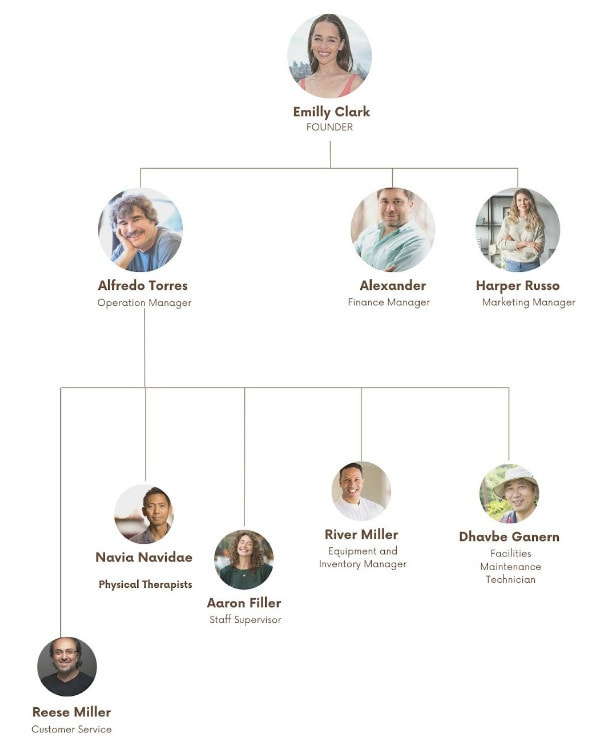
Operational Overview
Services
✔️Injury Rehabilitation: Provide individualized programs of care for the rehabilitation of injuries sustained in the course of everyday life, in the job or during athletic competition.
✔️Post-Surgical Rehabilitation: Assist patients in their recovery following orthopedic procedures including hip and knee replacements, ligament reconstructions and spinal operations by providing post-operative care. Rehab plans should be individualized for each kind of surgery.
✔️Chronic Pain Management: Develop treatment strategies for managing chronic pain conditions such as arthritis, fibromyalgia and chronic back pain. Utilize a combination of physical therapy techniques to improve mobility and reduce pain levels.
✔️Pediatric Physical Therapy: Offer physical therapy services for children with developmental disorders, injuries or congenital health conditions. Focus on improving motor skills, strength and coordination in a child-friendly environment.
✔️Geriatric Physical Therapy: Help the elderly with their mobility, balance, strength and general fitness by giving them specialized attention. This assists in boosting the quality of life and independence in the senior population.
Industry Analysis
The global physical therapy industry is a growing market estimated to reach a value of $113.5 billion by 2027 growing at a CAGR of 4.7% from 2022 to 2027.
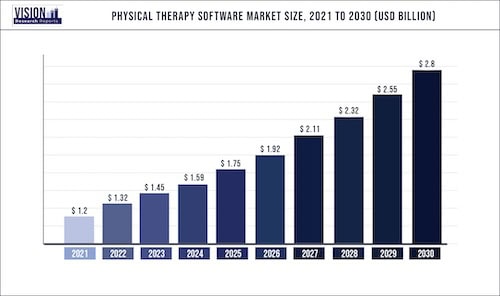
Source: Vision Research
Despite stiff competition, the physical therapy market is expanding rapidly across the world as a result of demographic shifts that include a longer life expectancy, higher rates of chronic illness and a shift toward more frequent use of outpatient facilities. In the United States, the business is undergoing tremendous development attributable to causes such as the growing healthcare spending and a rise in sports-related injuries. A combination of factors including rising public understanding of physical therapy’s value and bettering healthcare infrastructure in developing countries like China and India is driving rapid expansion in the Asia-Pacific area.
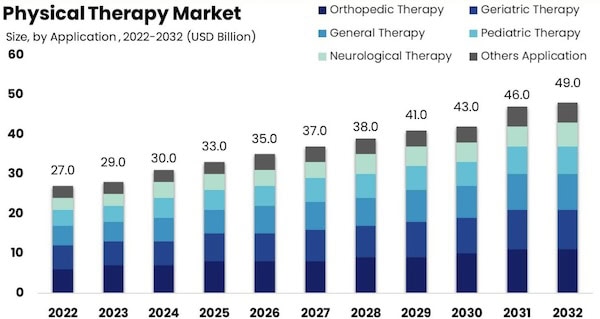
Source: Market Research
In addition, Europe is still a lucrative market especially in nations like Germany and the United Kingdom which have superior healthcare systems and spend more on healthcare overall than other countries. Even if huge corporations with a national or international reach and a comprehensive product line do exist, small and medium-sized businesses are the norm in this sector. You may find anything from the standard fare of physical therapy and rehabilitation to more niche offerings in fields like sports medicine and pediatric treatment. Despite difficulties such as different insurance policies and a lack of experienced specialists in certain places, the industry is adjusting by embracing technology such as telemedicine services, providing home therapy and implementing sophisticated treatment methods. Your company’s development prospects seem good given your flexibility and the expanding need for physical therapy services.
Other key trends and stats:
✔️Comprehensive Treatment Services: Offering a range of therapies including injury rehabilitation, post-surgical care and chronic pain management.
✔️Specialized Programs: Creating targeted initiatives for certain populations such as those requiring care for children, athletes or the elderly.
✔️Technological Integration: Utilizing advanced physical therapy equipment and technology for effective treatments.
✔️Preventive Care and Wellness: Using exercise as a means of injury prevention and general health promotion.
Industry Problems
✔️Affordability and Insurance Coverage: Physical therapy can be costly and insurance coverage varies significantly which can be a barrier for many patients.
✔️Accessibility and Location: Patients with mobility limitations or those residing in outlying locations may have difficulty reaching treatment centers.
✔️Availability of Specialized Treatments: Some patients may require specialized therapy services that are not available in all clinics such as sports rehabilitation or pediatric physical therapy.
✔️Qualifications and Expertise of Therapists: It might be challenging for patients to locate therapists who have the necessary specialized training or experience to effectively treat their disease.
✔️Personalized Treatment Plans: The need for customized treatment plans that cater to individual patient needs and goals is essential but can be challenging to provide consistently.
Industry Opportunities
✔️Flexible Pricing and Packages: Create price tiers or bundles to appeal to customers with varying financial capabilities. Services may be made more accessible and increase repeat business by offering loyalty discounts or special pricing for returning customers.
✔️Online Booking and Efficient Scheduling: Utilize an online booking system to streamline appointment scheduling. Offering various booking options including last-minute appointments, can accommodate clients’ busy schedules and improve business efficiency.
✔️Investment in High-Quality Products and Equipment: Customers that care deeply about the quality of their goods will be drawn to a business that regularly updates and maintains its skincare equipment and uses only the highest-grade products.
✔️Staff Expertise and Continuous Training: Hiring experienced estheticians and providing funding for their continued education improves the quality of care provided. Staff with varied skills may cater to a broad variety of skincare requirements.
✔️Creating a Relaxing and Inviting Atmosphere: Create a relaxing atmosphere with careful planning. Relax in the comfortable waiting room while enjoying the soothing music and tasteful design.
Target Market Segmentation
Demographic Segmentation:
✔️Age Groups: Provide targeted assistance to seniors and other age groups. Children may benefit from pediatric physical therapy, teenagers and young adults from sports therapy and seniors from geriatric physical therapy with an emphasis on mobility and pain control.
✔️Income Levels: Develop tiered service plans to meet the needs of people with varying degrees of disposable money. Some examples of this include standard rehabilitation services and intensive individualized treatment plans.
✔️Cultural Diversity: Embrace Miami’s multicultural population by offering culturally sensitive care and employing staff who speak multiple languages or understand specific cultural nuances.
Psychographic Segmentation:
✔️Active Lifestyle Enthusiasts: Target individuals who are keen on maintaining an active lifestyle, offering sports rehabilitation and injury prevention programs.
✔️Health and Wellness Focused Individuals: Provide services such as posture correction, ergonomic examinations and preventative care to persons who are actively seeking to improve their health and well-being.
Behavioral Segmentation:
✔️Chronic Pain Sufferers: Focus on patients with chronic conditions requiring ongoing therapy, offering pain management and quality-of-life improvement programs.
✔️Post-Surgical Patients: Provide specialized rehabilitation programs for persons recuperating from surgery with a focus on restoring function and mobility.
✔️Accident and Injury Recovery: Target individuals recovering from accidents or injuries offering tailored rehabilitation programs to aid in their recovery.
Geographical Segmentation:
✔️Neighborhood-Specific Services: Recognizing that various communities in Miami-Dade County have diverse demographic and lifestyle demands, localize service delivery. For instance, geriatric and joint pain-related medicines may be especially useful in regions with a large senior citizen population.
Technological Segmentation:
✔️Tech-Savvy Clients: Implement and promote advanced therapeutic technologies like telehealth services, virtual reality rehabilitation and app-based exercise programs for tech-savvy clients.
✔️Traditional Therapy Clients: Continue offering traditional hands-on therapy methods for clients who prefer a conventional approach to physical therapy.
Market Size
✔️Total Addressable Market (TAM) for Physical Therapy Services: The TAM for your physical therapy services comprises the whole potential market in your nation or area. Everyone from professional athletes to post-surgery patients to the elderly in need of mobility aids to people with long-term diseases like arthritis may at some time in their lives benefit from physical therapy. variables such as an aging population, the frequency of chronic illnesses and an increasing focus on rehabilitation and physical wellbeing are all variables that contribute to the increased potential and demand for physical therapy services which are reflected in the scope of TAM.
✔️Serviceable Addressable Market (SAM) for Physical Therapy Services: Your physical therapy service’s SAM is the TAM subset that you can reasonably expect to reach. Your clinic(s)’ location(s), the kind of services you provide (e.g., sports rehabilitation, geriatric care, post-operative recovery) and your areas of expertise all play a role in this categorization. If your clinic treats sports injuries and you’re in a very athletic or active part of the country then your SAM will likely target adults and athletes rather than children and their families.
✔️Serviceable Obtainable Market (SOM) for Physical Therapy Services: Your SAM’s capture probability is represented by the SOM. Your clinic’s present capacity, reputation, competition in the region, quality of treatment and marketing activities all have an impact on this subset, making it the most immediately actionable. Your SOM might be made up of members of the neighborhood around your clinic or a subset of the population such as seniors in an area where you have made a name for yourself. When you have a firm grasp on your SOM, you can better tailor your offerings, marketing efforts and resource allocation to fit the demands of this particular customer base.
Industry Forces
Market Demand and Health Trends: The rising rate of sports-related injuries and the increasing number of people requiring rehabilitation after surgery both increase the need for professional physical therapy.
Competition: Physical therapy clinics face competition from a wide variety of healthcare professionals and rehabilitation facilities. You may set yourself apart from the competition by providing services that are unique in terms of the ailments or therapies they address or the quality of care they provide their patients.
Technological Advancements: Knowledge of recent developments in rehabilitation science and therapy is essential. This involves investing in current therapeutic equipment and using digital technologies like electronic health records and telemedicine services.
Regulatory Environment: Keeping up with the latest developments in healthcare legislation and insurance reimbursements is crucial to maintaining efficient service delivery and billing practices.
Economic Factors: Patients’ capacity to pay for physical therapy treatments may be impacted by macroeconomic variables such as healthcare expenditure patterns and insurance coverage. Your company’s sales might go up or decrease depending on the economy.
Financial Statements
The financial model has all the important financial statements including Income Statement, Balance Sheet and Cash Flow Statement. In addition, the financial model includes 3 to 5 years of projections and can be edited using Microsoft Excel or Google Sheets.
Income Statement
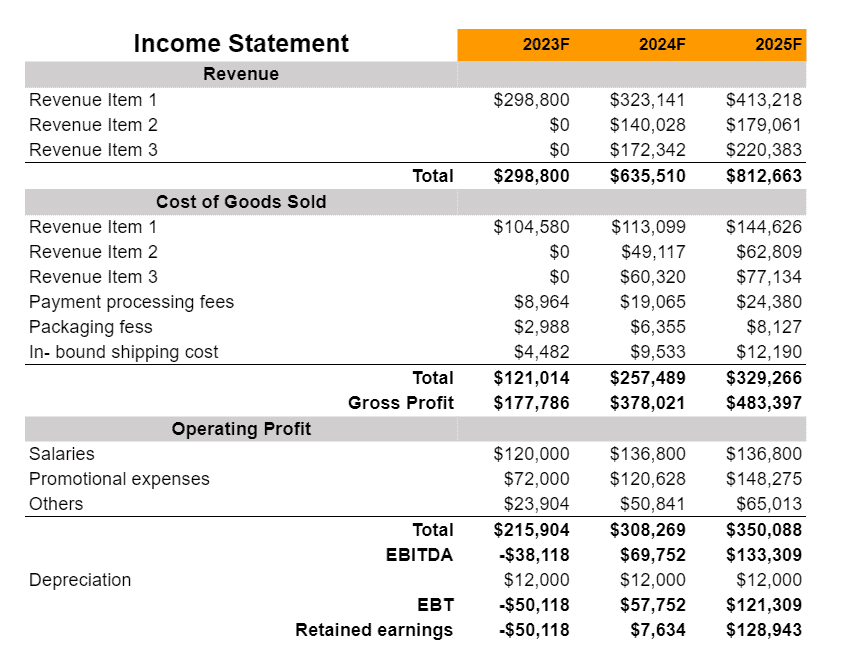
Cash Flow Statement
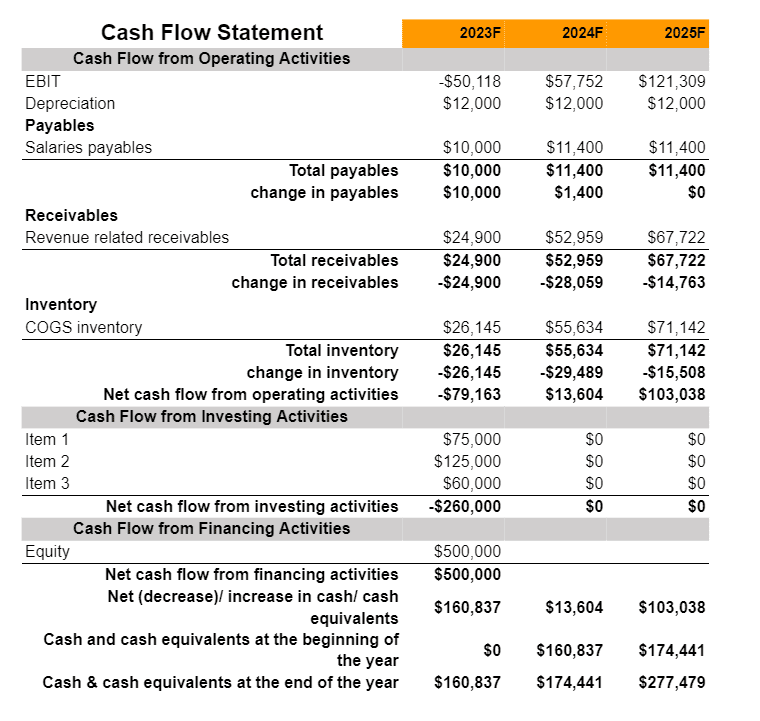
Balance Sheet
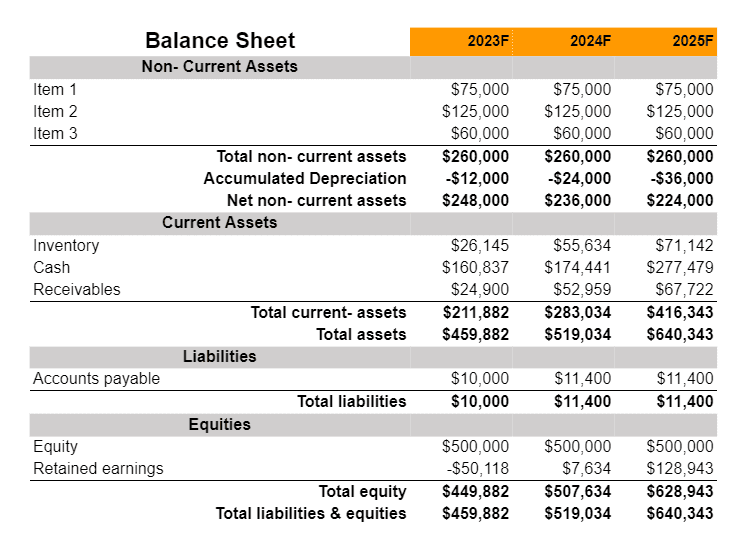
Revenue Summary
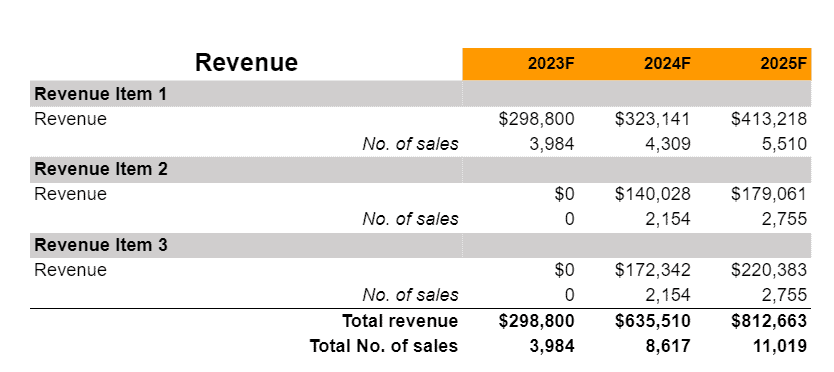
Cost of Goods Sold
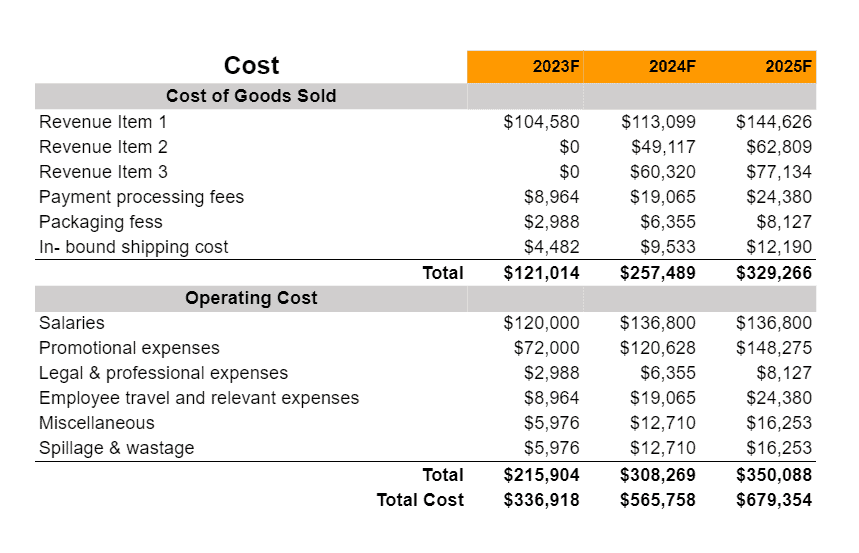
Related Articles on Business Plan:

